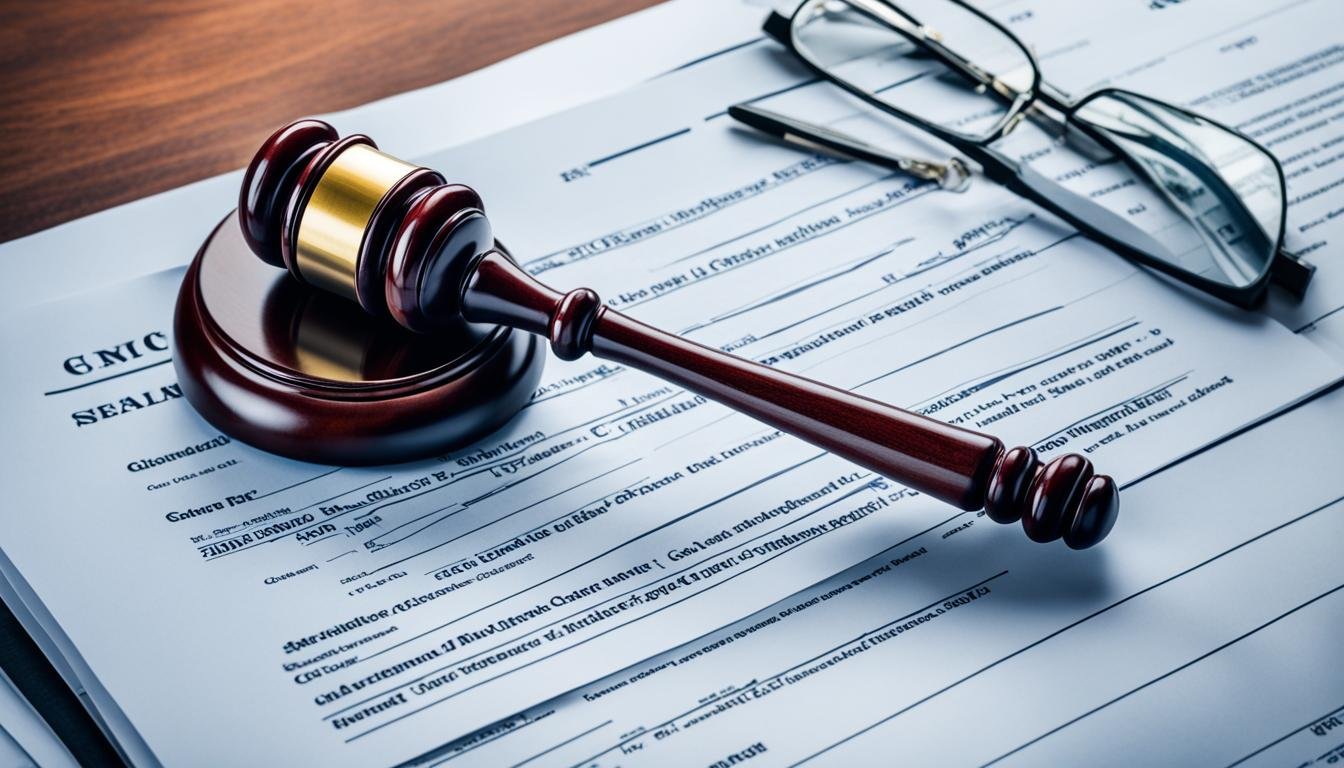Did you know California was the first state to make divorce easier? If you’re going through a divorce in California, knowing the steps is key. From filing to getting the final decree, it’s a complex process. But, with the right info, you can make choices that protect your future.
Getting a divorce in California usually takes at least 6 months. It has 4 main steps, the same for both married folks and domestic partners1. It’s vital to get ready mentally and financially for this big change. The choices you make now can affect your future a lot.
Key Takeaways
- California was the first “no-fault divorce” state, where a spouse only needs to state irreconcilable differences to file for divorce.
- The divorce process in California has 4 major parts and typically takes at least 6 months to finalize.
- Divorce in California involves filing paperwork, responding to the petition, temporary orders, financial disclosures, and a final judgment.
- After the divorce is finalized, there are important post-divorce steps to take, such as changing beneficiaries and updating financial accounts.
- Consulting with an experienced divorce attorney can help ensure a smooth and successful divorce process in California.
Overview of the Divorce Process in California
Going through a divorce in California can feel overwhelming. But, knowing the main steps can make it easier. The process includes filing for divorce, responding to papers, getting temporary orders, and sharing financial info2.
The Four Major Parts of Divorce in California
- Filing for Divorce: It starts with one spouse filing a divorce petition with the court3. You must live in California for six months and in the filing county for three months before you can file3.
- Responding to Divorce Papers: After the petition is filed, the other spouse has 30 days to answer. Not answering on time can lead to a default judgment3.
- Temporary Orders: Couples can ask for temporary orders for things like alimony and child support during the divorce2.
- Financial Disclosures: Both spouses must list their assets, debts, and finances through court forms2.
The divorce process in California usually takes about 6 months, whether it’s easy or hard2. Couples can settle or go to trial if they can’t agree. A judge will then decide on things like who gets what and child support2.

Understanding the divorce requirements in California can be tough. But, getting legal advice can help couples know their rights and what to expect, making the process smoother2.
“Divorce is one of the most difficult experiences a person can go through. It’s important to understand the process and seek professional guidance to ensure a fair and equitable resolution.”
Whether your divorce is uncontested or contested, it’s key to follow the legal steps and have all your documents ready before filing in California32.
Preparing for the Divorce
Before starting the divorce process in California, there are key steps to take. First, collect and copy important papers like tax returns, bank statements, and insurance policies4. This helps you understand what you own and owe together. Also, change passwords and take back personal items from shared accounts and places to protect yourself5.
Listing your household items is also smart. It makes it clear what you got during the marriage. This list is key when dividing things, as California says everything must be split equally5. Keeping your credit safe is another must-do. It makes moving on after the divorce easier.
Talking to a divorce lawyer is a big help. They can guide you through the process and help protect you. They’ll tell you about California’s rules, like living in the state for six months before filing45. They’ll also tell you about quick divorces if you meet certain conditions4.
It’s also key to plan how to tell your kids about the divorce. Doing it right can lessen the blow and help everyone adjust better.

By doing these things, you can handle the divorce in California better. Being ready, organized, and informed is the way to a better outcome. Remember, this big change is easier with the right preparation.
Filing and Responding to Divorce Papers
In California, starting a divorce means either serving papers to your spouse or answering the papers they’ve filed6. Neither way is better than the other. You must fill out important court forms. The court checks these forms to make sure everything is correct before giving the final judgment6.
If you’re filing for divorce, you must serve the divorce papers to your spouse. If your spouse has filed first, you have a deadline to answer the petition. In an uncontested divorce, you must answer within 30 days of being served6. Not answering on time can lead to a default judgment against you6.
To answer a divorce petition in California, you use specific court forms. These include the Response to Petition for Dissolution (FL-120) and other documents6. Answering can lead to talks or settlements as both sides try to agree on things6.
In contested divorces, serving divorce papers can be tough6. But, it’s key to answer on time to protect your rights and keep the process moving6. Court hearings, discovery, and possibly settling are steps that come after serving papers7.
Whether you’re filing or answering, knowing the timelines, forms, and legal stuff is crucial6. Learning about these steps helps you handle the divorce in California better7.
Temporary Orders and Financial Disclosures
Before your divorce is finalized in California, you may ask for temporary orders. These orders cover important things like alimony, child support, and who gets what property8. You and your spouse must also fill out financial disclosure forms. These forms list your assets, debts, income, and expenses, which is needed for the divorce process8.
Temporary Orders
Temporary orders are key in California divorces. They set the rules for your life while you wait for the final divorce8. The orders made now will stay until the divorce is done. So, think carefully about what you ask for.
Financial Disclosures
Financial disclosures are a must in California divorces. You and your spouse must give detailed financial info8. This includes your assets, debts, income, and expenses. The court uses this info to decide on things like spousal and child support, and how to split property. Not giving accurate financial info can slow down the divorce or lead to court penalties.
Knowing about temporary orders and financial disclosures helps you handle the divorce court California better. It makes the process smoother towards ending your divorce89.
“Temporary orders and financial disclosures are crucial steps in the California divorce process, helping to establish the terms and conditions before the final decree is issued.”
Divorce finalization California
To finalize a divorce in California, you must fill out final forms and submit them. The court checks these to make sure everything is correct before signing the final judgment. This judgment shows the exact day the marriage or domestic partnership ends10.
The filing fee for divorce in California is between $435 to $45010. There’s also a six-month waiting period before the divorce can be finalized10. The divorce process in California has four main steps: filling out forms, submitting them, waiting six months, and filing final paperwork10.
If one spouse doesn’t respond, you can get a divorce by default. You provide the court with the needed information10. Mediation is often used to help couples settle disputes during the divorce process10.
The earliest a divorce in California can be finalized is after six months of serving divorce papers, due to the waiting period11. But, divorce cases in California usually take six months to a year to finish11. Factors affecting the duration include child custody, property division, and spousal support11.
Divorce trials can be costly and stressful, potentially harming the relationship. But, different cases have different timelines. Uncontested cases are quicker, while contested ones can take longer1011.
To speed up the divorce, couples can agree outside court, show proof of asset ownership, and hire a skilled divorce attorney11.
Discovery and Settlement
The discovery process in a California divorce lets you legally get info from your spouse if they’re not being open or hiding things12. This step isn’t needed if both parties are honest and share all the details12. If you and your spouse agree on everything, you can skip trial and get the divorce done faster13.
Discovery
In the discovery phase, you can use legal tools to get the info you need. You can send written questions called interrogatories that must be answered within 30 days12. If someone doesn’t answer, they could face court penalties12. You can also ask for the other party to confirm or deny certain facts, and they have 30 days to respond12. You can inspect the other party’s property with a 30-day notice12. All these steps must be done at least 30 days before trial starts12.
You can also make witnesses give testimony through subpoenas and record their sworn statements with a court reporter12. You can ask for electronic messages, emails, and digital files too12.
Settlement
If you and your spouse agree on everything, like custody, support, and how to split things, you can skip trial13. This makes the divorce process quicker and cheaper. In California, you must live in the county where you file for divorce for at least three months and in California for six months before filing13. The quickest way to finalize a divorce here is 6 months and 1 day from when you file or serve the papers13.
If one spouse doesn’t answer the divorce papers within 30 days, a default judgment can be given, affecting custody, support, and asset division13. California also lets you finalize a divorce even if one spouse doesn’t sign the papers, if the other spouse doesn’t respond in 30 days13.
For marriages of less than five years with no kids, few assets, and no spousal support asked for, California has a quicker way to get a divorce if both agree on the division1312.
Trial and Post-Judgment Matters
If you and your spouse can’t agree, your divorce case will go to trial14. A judge will then decide on things like who gets what, child support, and custody14.
After the trial or agreement, you’ll need to get the final judgment signed by a judge15. This means filling out forms like FL-180 and FL-190, and maybe adding things like spousal support or property orders15.
Once your divorce is done, you can deal with any issues that come up16. In California, you can go back to court to change or enforce past judgments16. This is rare in other cases16. Changes in life, like job changes or health issues, might mean you need to adjust things like child visitation or support16.
The law says you can’t avoid paying support by not working hard enough16. If a judge thinks you could be earning more, they might use that in court16. You’ll need proof of these changes, like pay stubs or job offers, to get things changed16.
Instead of going to court, you can change things with your ex’s help and a lawyer16. This can save time and money compared to court16.
“The completion of a divorce or legal separation is confirmed with the receipt of the Notice of Entry of Judgment marked “filed,” which includes the official end date of the marriage or partnership.”
| Post-Divorce Matters | Description |
|---|---|
| Child Custody/Visitation | Changes in circumstances can lead to modifications in child custody and visitation arrangements. |
| Child Support | Child support orders can be modified based on changes in income, jobs, incarceration, or additional children. |
| Alimony/Spousal Support | Spousal support segments of a divorce judgment are subject to modification based on relevant factors. |
| Estate Planning | Divorcees may need to review and update their estate plans, including wills, trusts, and beneficiary designations. |
| Account Ownership | Changes in account ownership and access may be necessary after the divorce is finalized. |
| Retirement | Divorcees may need to adjust their retirement plans and account allocations post-divorce. |
Conclusion
The17 divorce process in California can feel complex and overwhelming. But, by understanding the steps and being prepared, you can make it smoother. It’s key to know the requirements, timeline, and what comes after the divorce18. The team at Super Attorneys Of Irvine is ready to guide and support you through the whole19 divorce process in California. Visit businesslawyersirvine.com or call 949-996-9546 to learn more.
During the divorce process, you’ll have to fill out many forms and share information18. You’ll need to use forms like the Appearance, Stipulations, and Waivers (form FL-130), the Declaration for Default or Uncontested Dissolution or Legal Separation (form FL-170), and the Judgment form (FL-180)18. Getting help from a family law attorney, financial advisor, or therapist is crucial to understand California’s divorce laws19.
The17 divorce process in California can take a few months or even years, based on your case’s complexity and settlement agreement19. It’s vital to stay organized, follow all legal steps, and make smart choices for a smooth divorce finalization18. With the help of the experienced team at Super Attorneys Of Irvine, you can understand California’s divorce laws and get the best outcome for your situation19.
FAQ
What are the major steps in the divorce process in California?
How long does it take to get a divorce in California?
What steps should I take to prepare for a divorce in California?
What are the key forms involved in the divorce filing process in California?
What are temporary orders and financial disclosures in a California divorce?
What happens to finalize a divorce in California?
What is the discovery process in a California divorce?
What happens if I can’t reach a settlement agreement with my spouse?
What post-divorce matters should I consider in California?
Source Links
- https://hooverkrepelka.com/guide-divorce-california-step-by-step-process/
- https://cristinlowelaw.com/california-divorce-process-ten-steps/
- https://divorce.com/blog/california-divorce-process/
- https://www.legalzoom.com/articles/10-steps-to-getting-divorced-in-california
- https://divorce.com/blog/california-divorce-checklist/
- https://temeculadivorce.com/step-by-step-guide-responding-divorce-papers/
- https://www.leonfbennettlaw.com/blog/what-happens-in-california-after-divorce-papers-are-filed/
- https://sf.courts.ca.gov/self-help/divorce-separation-annulment
- https://azemikalaw.com/exploring-divorce-timelines-in-california-how-long-does-the-process-take/
- https://hellodivorce.com/divorce-in-california/how-to-finalize-divorce
- https://www.lemkinlaw.com/blog/how-long-does-a-divorce-in-california-take/
- https://www.gillekaye.com/legal-blog/2022/november/discovery-is-an-important-fact-finding-process-i/
- https://www.edgarfamilylaw.com/blog/california-divorce-process-step-by-step/
- https://sullivan-law.com/8-steps-to-divorce-in-california/
- https://selfhelp.courts.ca.gov/divorce/finalize-divorce/after-trial
- https://www.sandiego-divorceattorney.com/practice-area/divorce/post-judgment-enforcement-modifications
- https://www.wf-lawyers.com/divorce-works-california-complete-guide/
- https://selfhelp.courts.ca.gov/divorce/finalize-divorce/written-agreement
- https://www.stegmeierandgelbart.com/divorce-overview/

